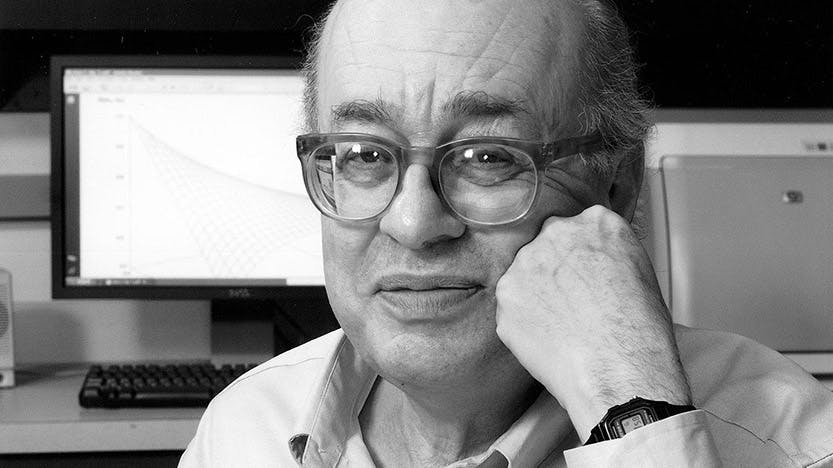Thomas Nagylaki, Professor Emeritus of Ecology and Evolution, 1944-2019

Thomas Nagylaki, PhD, professor emeritus in the Department of Ecology and Evolution and a member of the Committee on Genetics, Genomics & Systems Biology at the University of Chicago, died at the age of 75 on Feb. 10, 2019. The cause of death was complications from chronic liver disease.
Nagylaki studied theoretical population genetics — primarily, as he put it, the “formulation and analysis of models for geographical variation, random genetic drift, natural selection and gene conversion in multigene families.” His aim, he posted on his website, was to “augment our understanding of the genetic structure and evolution of natural populations.”
Nagylaki may have been best known for his early work on theoretical population genetics, but according to his friend and colleague, Reinhart Burger, PhD, a mathematician at the University of Vienna, he also produced “subtle and beautiful new results over the past 10 years.”
“He was a unique intellect and a quintessential University of Chicago professor,” Burger added. “He will be sorely missed.”
“Tom was a very rigorous scientist and a valued colleague,” said Chung-I Wu, PhD, former chairman of Ecology and Evolution at the University. “He could spot the flaws, the logical gaps in your research plan. Then he would push it to the limit. He generally had the last word on any subject.”
At the same time, “he was brutally honest,” Wu added. “Sometimes he ruffled feathers. Several students, and probably some of the faculty, may have been intimidated by his intellect. But there was seldom, if ever, a gap in his reasoning. Once you got to understand and accept his style, he could be really helpful. He criticized but also authenticated other people’s work. When you heard encouragement from him,” Wu said, “you knew you were safe.”
“It was fascinating to be around Tom,” said Martin Kreitman, PhD, professor of Ecology and Evolution at the University of Chicago. “In terms of sheer intellectual computing power, I’ve never run across anyone like him. He was drawn to theoretical projects that were difficult to prove, but he solved them with subtlety and creativity. His writing was exquisitely precise.”
“He rarely worked with other people,” Kreitman said. “When he did it was mostly with other mathematicians. They were often awed by him.”
In terms of sheer intellectual computing power, I’ve never run across anyone like him.
Thomas Andrew Nagylaki was born Jan. 29, 1944 in Budapest, Hungary. His father was killed in World War II. In 1957, his family escaped from Hungary, passed through Switzerland, then moved to Canada. He graduated from McGill University in 1964 with first-class honors in physics, then completed his physics PhD in 1969 at the California Institute of Technology. After graduate school, Nagylaki worked as a research associate for two years at the University of Colorado, followed by a visiting assistant professor role at Oregon State University.
His first eight published papers were all about physics. In 1972, however, he switched fields, shifting his focus from physics to medical genetics, but preserving the mathematical component. He worked closely for three years with a pioneer in the field, James F. Crow, PhD, the chair of the departments of Genetics and Medical Genetics at the University of Wisconsin, Madison. Nagylaki was a project associate in the Crow laboratory and an assistant scientist in medical genetics.
In 1975, Nagylaki moved to the University of Chicago. He rose from assistant professor of Biophysics and Theoretical Biology, to associate professor in 1977, to professor of in 1983. In 1984, he changed departments, joining Molecular Genetics and Cell Biology. In 1989, he moved again, into the department of Ecology and Evolution, which became his academic home for nearly 20 years.
He authored two biomathematics textbooks that were designed to appeal to advanced college students with a gift for mathematics. The first, Selection in One- and Two-Locus Systems, published in 1977, was based on one of his courses at the University of Chicago. “The only prerequisites,” he noted, “were calculus and matrices.”
His second textbook, published in 1992, was an introduction to Theoretical Population Genetics. It covered “areas of theoretical population genetics that can be investigated rigorously by elementary mathematical methods.”
Nagylaki also took on various editorial positions. Between 1976 and 1987 he served as an editor, member of the editorial board, or member of the advisory board for three scientific journals — two that focused on mathematics and one devoted to biology. He also served on the National Research Council’s Committee on DNA Forensic Science from 1994 to 1996.
He took emeritus status in 2008, but remained active. He authored a total of 122 academic papers, including 12 published after his formal retirement.
Beyond his academic excellence, “Tom had authoritative knowledge and interest in modern history, especially modern spy-craft,” Kreitman said. “He also demonstrated an inordinate love of dogs, particularly his companions, Shirpa, and then Orca, who were well known by his neighbors. That, together with his unusual ability to engage friends in knowledgeable talk, often for hours on end, is how many will remember him.”
His colleagues are waiting for one more, longer than usual, highly anticipated paper that is now in the queue. “He spent two years working on it,” according to Kreitman. “He told me he had 600 pages of notes.” Nagylaki’s final manuscript — “Not my worst,” he jokingly told colleagues — has been submitted.
